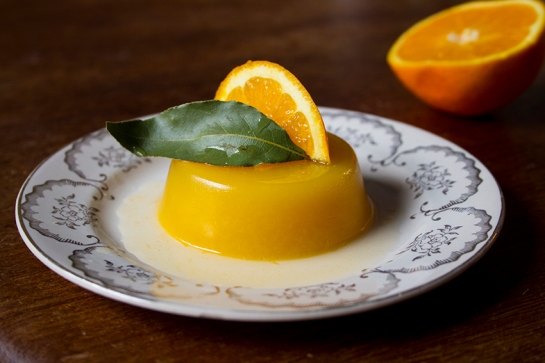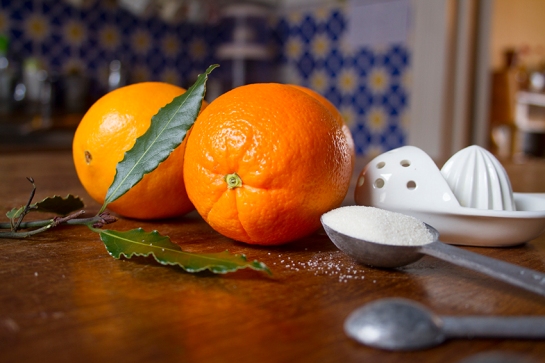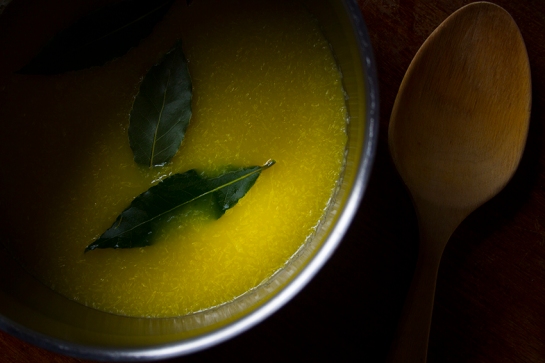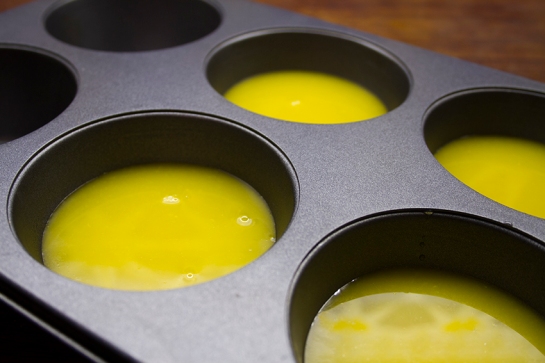Orange and Bay Jelly
*** MY NEW SITE IS LOCATED HERE ***
 This recipe was inspired by one of my favourite cookbooks, ‘A Year in My Kitchen’ by Skye Gyngell. It’s a beautiful book in every sense of the word – the recipes, the writing and the photography.
This recipe was inspired by one of my favourite cookbooks, ‘A Year in My Kitchen’ by Skye Gyngell. It’s a beautiful book in every sense of the word – the recipes, the writing and the photography.
Skye Gyngell’s recipe is for blood orange and rosemary jelly. I make mine with other sweet orange varieties (like navel or valencia) which are readily available, but I have also used blood oranges when in season. I replace the rosemary with fresh bay leaves (we have numerous bay trees growing in our garden – they are prolific multipliers) and find that they add a lovely bittersweet floral scent and an ever so delicate flavour to the tangy orange. You can use dried bay if you can’t get hold of fresh leaves but use less as they have a more concentrated flavour, as with all dried herbs.

My recipe uses considerably less sugar than most others – just 2 tablespoons – so it’s relatively child-friendly for a dessert, especially for a jelly. Blood oranges can be more tart than other types of sweet oranges as they contain hints of raspberry in their flavour profile. So when using the sanguiferous variety you could up the sugar content of my recipe if you want to (Skye Gyngell recommends 100g of caster sugar for 600ml of blood orange juice).
This is an incredibly easy and quick recipe, and looks beautiful on the plate – meaning it’s perfect for children to help make or a cute little number to put together for a grown-up feast. The jelly is best served on the day it’s made but will happily sit in the fridge overnight to be gobbled up for lunch the next day.
Also, it’s worth noting that I personally use vegetarian gelatine in the form of agar agar although my recipe denotes amounts for agar-agar, leaf and powdered gelatines. Agar agar is a mixture of complex carbohydrates (rather than animal proteins) and minerals derived from gelidium seaweed species of Red Sea algae. It gives you a more set and chewy jelly compared to the silky, melt-in-the-mouth jellies you get from using gelatine. (Find out more about agar agar at this great site). However, do refer to the instructions on all vegetarian, leaf (or sheet) or powdered gelatine packets as strength differs from product to product.
Serves 4
Ingredients
500ml freshly squeezed orange juice (I use navels, Valencias or blood oranges, depending on availability) plus a little extra for serving (about 8 oranges worth, depending on their size)
1 orange for serving
2 tablespoons caster sugar (I used golden)
3 fresh bay leaves (or 1 dried bay leaf)
1.5 teaspoons of agar agar or 3 sheets of medium-strength leaf gelatine or an 11g sachet of powdered gelatine
Sunflower oil for greasing moulds
Individual pudding/jelly moulds or a muffin tray (this is what I use and it makes 4 perfect little jellies!)
Method
Lightly crush your bay leaves (or bay leaf, if using dried) between your fingers to release their flavour and scent, which will infuse the jelly. Add the bay to a saucepan and pour on the orange juice and sugar. Place the pan over a gentle heat, stirring occasionally to dissolve the sugar.
Whilst your pan is heating, and if using leaf gelatine, soak the gelatine sheets in a bowl of cold water for 5 minutes. Then remove from water and squeeze out excess liquid. If using powdered gelatine follow the packet instructions for use. If using agar agar, soak in cold water and remove after 5 minutes but then add to the saucepan and boil together with the juice, sugar and bay for another five minutes – this activates the setting agents in the agar (gelatine has a lower setting temperature so you never add gelatine to liquid if it is still boiling).
Once your juice has come to the boil, remove from the heat and add the gelatine (if you’re using agar agar skip this step as you have already added your setting agent). Stir to ensure the gelatine has completely dissolved.
Then, using a sieve, strain the juice into a jug to remove the bay leaves and pith.
Using a little oil, wipe round your moulds before pouring in the warm liquid. Set aside to cool completely and then pop in the fridge for a couple of hours to set.
When ready to serve (ideally on the day you make them), briskly dip the bottom of the mould (or muffin tray) in warm water and run a palette knife around the edge of the jelly to dislodge. Squeeze a little juice and place a slice or two of orange (peel and pith removed) on each plate, and complete with your little wobbly jelly balanced atop.




Pingback: Wibble wobble, wibble wobble «
Yummy xx
Sent from my iPhone
Thanks MUM! xxx
This sounds lovely 🙂 We also have a prolific bay tree so use the leaves a lot – definitely going to try this recipe though. Bey-infused custard is also heavenly!
Thank you! I’ll be trying the custard soon too!
Pingback: Oranges and Lemons (Preserved) |